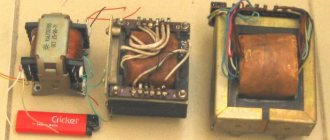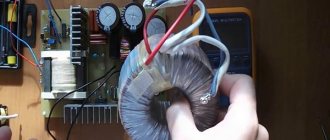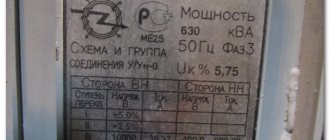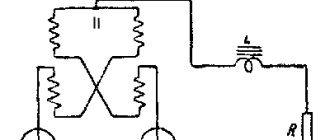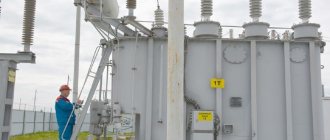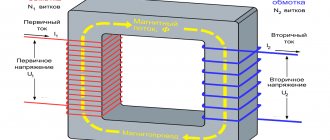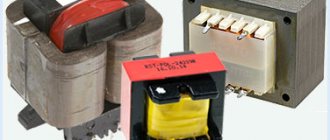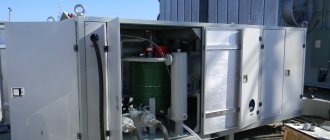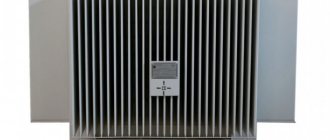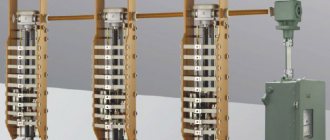While the transformer is operating in an electrical installation, it gradually loses its original properties, and without proper maintenance it will simply fail. This comes from the constant negative influence of electrodynamic, thermal and mechanical loads. In order to prevent failure of any transformer, it is necessary to carry out, in addition to daily external inspection, the following types of repairs:
- Current;
- Capital.
They are scheduled preventative maintenance. There is another special type of repair - extraordinary. It is carried out if a defect is detected if it can lead to failure. This decision is not made by ordinary electrical personnel; this must be done either by the Consumer’s manager or by the person responsible for the electrical equipment of a given workshop or site. The staff only reports to their management about malfunctions.
One of the most common types of transformers in production has the abbreviation TMG (oil sealed transformer) and is used in almost all types of substations and distribution devices. Repairing windings and servicing them is a very difficult task, since just to inspect them you need to drain all the oil and disassemble the hermetically sealed housing.
Who sets the frequency of current transformer repairs?
Depending on local operating conditions, as well as the condition of the transformer, routine repairs are carried out as necessary. Their frequency is established by the technical manager or the person responsible for electrical equipment. Most often, these works are performed at least once a year. Sometimes this period can be extended to once every three years. Major renovations are a slightly different story. Major repairs are carried out according to the standard nomenclature of work and should be carried out:
- For transformers of 110 kV and above, with a power of 125 MVA and more, no later than 12 years after its commissioning. This is done taking into account the results of diagnostic control. Further repairs are made as necessary;
- All other less powerful transformers (TMG) are subject to major repairs in accordance with their condition and based on the results of diagnostic control.
Composition of maintenance of transformer substations
Periodic and unscheduled inspections by maintenance personnel, as well as scheduled or unscheduled repairs, if necessary, are of great importance for maintenance.
When carrying out inspections and repairs, the safety rules specified in the standard manual on labor protection for electricians for substation maintenance are observed. TI R M-068-2002 and standards PTEEP (chapter 2.2.) and PTB (chapter 1.3).
Maintenance work is carried out in accordance with the rules of PUE-7 specified in section 4.2. 1-4.2.16 Distribution boards and substations with voltage above 1 kV. (date of entry 2003.11.01.)
Output for repair of a power transformer sequence
The task and features of grounding transformers.
During operation, any transformer, step-down or step-up, is taken out of operation emergency in the following cases:
- Internal crackling, which is characteristic of an electrical discharge between two oppositely polarized conductors;
- Abnormal or uneven noise that occurs both with and without load;
- In case of unreasonable heating, which increases even with rated load and proper cooling;
- In case of oil emissions, which can be from the expander or from a damaged exhaust pipe diaphragm;
- In case of severe oil leakage, as well as when the minimum permissible level is reached;
- After receiving bad results from a chemical analysis of the oil from the laboratory.
The sequence of actions of personnel when taking a transformer out of service for repair is clearly regulated and signed. Depending on local conditions and the switching circuit of the transformers, these switchings may differ slightly from each other, but the basic logical chain still remains the same. The main thing is that they must be carried out without consequences for the powered equipment and for sources consuming electricity, and also safely, that is, using both basic and additional personal protective equipment.
Here is the sequence of shutdowns and switchings in the circuit of a step-down three-phase oil or dry transformer of a substation in order to take it out for repair:
- If there is a sectional disconnector and an oil switch on the low side, then to ensure uninterrupted power supply to power consumers. in this case, the disconnector is turned on first and only then the sectional oil switch;
- The oil switch is turned off on the low side. Now both sections are powered by one transformer, which will power both sections during the repair of the other. Naturally, this is if there are only two of them, like transformers;
- The input oil switch is turned off, that is, on the high side;
- Now it is possible to provide a visible break to the power buses of a transformer being taken out for repair by disconnecting the linear or bus disconnectors;
- Portable grounding connections must be installed on the low and high sides, naturally, after directly checking the absence of voltage and posting safety posters.
After that, a team is allowed to visit the transformer being repaired, in compliance with all organizational and technical measures.
Inspection procedure
The verification procedure is strictly followed. The point is not even that the instructions help to strictly follow the plan and not forget anything, but about convenience and reducing the time required to carry out the procedure.
Load
The transformer load is monitored by ammeters. They are connected to devices, all types of existing loads are measured. The data will be compared with the tabular ones.
The degree of equipment overheating based on the size of the load is understandable. To ensure that there is no increase in temperature, which could lead to failure of the unit, systematic monitoring is carried out regularly based on the readings of ammeters. Supplied with devices with power from 1000 kVA and above.
Monitoring oil and ambient temperatures
This is the second step you pay attention to when inspecting industrial transformers. If work is carried out with indicators higher than acceptable (but not higher than the final norm), the service life of the windings is significantly reduced. Insulating oil becomes unusable when exposed to high temperatures.
To continuously measure the temperature on most parts of the car, there is a special mercury thermometer. The most modern models are equipped with thermal imagers.
According to the standards adopted in Russia, the minimum operating temperature of the oil in a power transformer at an ambient temperature of no more than 35 degrees should not exceed 95 degrees.
IMPORTANT! In this case, the maximum permissible difference between the ambient and oil temperatures is 60 degrees.
Oil level and color
The oil level is indicated by a special switch located on each transformer. There are modern options that automatically read volume information. But if the level can be changed by simply adding oil, then the situation is different if it has lost its color.
The optimal color is from light yellow to golden yellow. This means there are no contaminants, impurities or other components that affect performance. If the oil darkens or appears brown or brown, be sure to replace it. Working with low-quality components threatens the breakdown of structural units.
External condition of insulators
It is necessary to check the external condition of the insulating materials. The appearance of defects may affect the safety of use of the transformer. The insulator is inspected for:
- cracks;
- traces of overlap;
- mastic exit points; strong folds;
- pollution.
All insulators are carefully checked. When contamination is detected, the nature of its occurrence is calculated.
Checking the grounding condition
The quality of grounding affects the safety of operating personnel. It is tested empirically, after which they also try to see if oil is leaking from the device body.
Listening to Noise
There will definitely be noise when the transformer is operating. But its characteristics say a lot about the functioning of the mechanism. Typically operating equipment has smooth noise characteristics without measuring tone or volume levels. The person conducting the inspection should turn off the fans to hear the noise. If clicks and crackles are heard, there is a change in tone or gain, or a decrease in volume frequency, then a thorough check is carried out.
Primary voltage control
This indicator is also important for testing, as it determines the performance of the mechanism. The maximum permissible excess of the primary voltage indicator is five percent of the norm, which is indicated in the service sheet. Please note the department number.
Assessment of the condition of the premises, the degree of compliance with safety regulations
The installed devices and the room itself directly affect the quality and safety of the transformer. Also checked:
- Is there a fire extinguishing agent and what quality?
- Is the ventilation system working?
- what temperatures are maintained;
- Is the room itself neat, are there any drafts, etc.
Typically, according to the plan, this function is practically lost during a routine inspection; all that remains is to check the date of the fire-fighting equipment.
No oil leakage
During an external inspection, they check not only the condition of the oil (its level and color), but also the absence of leaks. Even a minimal release of the composition leads to a decrease in device performance. It also increases the risk of injury in the workplace.
State of silica gel
Loss or change in the composition of silica gel occurs quite rarely, but nevertheless, during a preventive examination, this feature is taken into account. Defects can lead to contamination and damage to structural elements. This replaces silica gel.
Integrity of oil glass
The sight glass allows you to determine the oil level, which affects operating efficiency. The integrity of the glass is important for proper operation and convenient viewing of information.
Current repairs of power transformers
Features of the application and selection of measuring current transformers
The scope of work performed during routine repairs includes:
- Thorough external inspection;
- Cleaning the body, wiping insulators;
- Tightening of all bolted connections, special attention should be paid to current-carrying connections; if they are oxidized, they must be unscrewed, cleaned and re-tightened;
- Checking the cooling system and the operation of the oil indicator device;
- Activation of gas protection and cleaning of block contacts in it;
- If there are automatic cooling devices, it is necessary to check their operation and functionality;
- Draining water and condensate from the expander sump;
- Checking the moisture level of silica gel. Pink particles must be replaced with new ones;
- Add oil to the expansion tank if necessary;
- Measuring the insulation resistance, this procedure is performed with a megger rated for a voltage of 2500 Volts. The instrument error should not exceed 10–15%.
If minor faults are noticed between routine repairs during operation, they must be corrected by repair personnel. In this case, the number of components and parts that must be replaced with new ones should be minimal.
During routine repairs of dry transformers, it is necessary to remove the casing and make sure that there is no electrical heating or mechanical damage to all its parts. After covering, be sure to blow with compressed air, only after that put the casing back. Repair of a pulse transformer due to its small dimensions can be carried out even at home.
In what cases is an extraordinary inspection carried out?
If a single defect is detected, an extraordinary inspection should be carried out. It should be:
- loss of oil in the tank;
- discrepancy between the level of composition and the declared level;
- change in the condition of insulators;
- the presence of chips and cracks in the insulation;
- deterioration of buses and cables;
- wear of contact connections;
- current peaks.
Listen carefully to the noise. An audit is carried out if the type of noise differs from what is normally present.
Sources
- https://OTransformatore.ru/silovoj/osmotr-silovyh-transformatorov/
- https://OFaze.ru/teoriya/tehobsluzhivanie-transformatora
- https://www.kesch.ru/info/articles/tekhnicheskoe-obsluzhivanie-transformatornykh-podstantsiy/
- https://elekom21.ru/articles/obstrans.html
Overhaul of power transformers
Features of the application and design of welding transformers
During a major overhaul, the cover must be opened and all components thoroughly checked. After which it is tested in accordance with regulatory documents. Repair of large power oil transformers (TMG) is carried out directly at the installation site using prefabricated structures, without sending it to a repair shop. If there are transformer towers built near switchgears or repair areas of machine rooms with access roads, then they will also be used. Repair of oil transformers (TMG) should include a complete replacement of old oil with new one.
Low power transformers (welding, pulse, etc.) are repaired in specially equipped workshops or repair shops. These premises must reliably protect disassembled transformers from dust and various atmospheric precipitations getting on their parts. Types of particularly important work that should only be performed by highly specialized workers with the skills and knowledge:
- Delivery of TMG to the repair site. Its loading, unloading and transportation;
- Removing contact terminals;
- Repair of the active part of the transformer;
- Moving and installing individual components and assemblies.
Moreover, workers must be able to efficiently perform not only electrical work, but also rigging. After completing the appropriate training, passing exams, and also receiving a supporting document. The technological process of repairing a transformer must be carried out efficiently and strictly according to schedule; then this unpretentious equipment will last for decades. Testing a transformer after repair comes down to:
- determination of the transformation ratio. It is defined for all existing windings and branches;
- measuring the insulation resistance of windings;
- supplying increased voltage to the primary winding. Each winding is subjected to this test. The technology of this process is performed using a step-up autotransformer. It is this that makes it possible to increase and decrease the test voltage smoothly
Why is it needed?
Inspecting a transformer helps prevent all sorts of damage not only to itself, but also to other devices and devices connected to it.
The electrical system and vehicle interior require constant monitoring in large-scale production where power is supplied continuously. For less used equipment, checks are performed less frequently. The operation is fraught with a number of difficulties. Even choosing a high-quality car from a reliable supplier and working without a single violation, even the smallest one, does not guarantee that the transformer will not break and will last a long time. An inspection helps identify problems related to:
- change in oil temperature;
- reduction in performance qualities of insulating materials;
- presence of oil leakage from the device;
- violation of grounding integrity;
- load change;
- changes in primary supply voltage indicators and much more.
The occurrence of these problems leads to the loss of the vehicle's performance (if it does not completely fail, it shows low efficiency). Negative aspects contribute to the breakdown of structural components and additional parts, and also negatively affect the final result of the work. In addition, grounding and insulation problems can cause enormous harm to personnel, including death.
Therefore, identifying defects and eliminating them is a primary task in production.
Repair of welding transformers
Before proceeding directly to repairing the welding transformer, you should make sure that the terminals for connecting the power wire are not burned. The terminal block to which the ends of the welding wires are connected is the weakest point of this device. Phase short circuits of the windings are rare; most often these are short circuits to a grounded frame, and if they do occur, then strong heating will be observed. That is, when repairing welding transformers, you need to pay special attention to all bolted connections, since after all, the welding process is associated with the constant operation of the transformer in short circuit mode. This repair is also aimed at revising the mechanism connecting the core and securely securing the windings to the magnetic core. Repairing windings is a very rare procedure and it comes down to applying a special varnish to damaged areas or completely replacing it with a new one.
High-quality current and overhaul repairs of transformers, carried out in full, often become the main component of its long-term, trouble-free operation.
Why is maintenance needed?
The purpose of transformer maintenance is to monitor the current condition of the equipment, timely identify faults and eliminate them, carry out routine operations to add oil, adjust components, and measure relevant characteristics. The listed measures are aimed at eliminating emergency situations that could result in electrical equipment failure.
Transformer overhaul video
Coffee capsule Nescafe Dolce Gusto Cafe O Le Coffee with milk, 3 packs of 16 capsules each
1305 ₽ More details
Coffee capsules Nescafe Dolce Gusto Café Au Lait, 16 pcs.
435 ₽ More details
RAM for laptops

